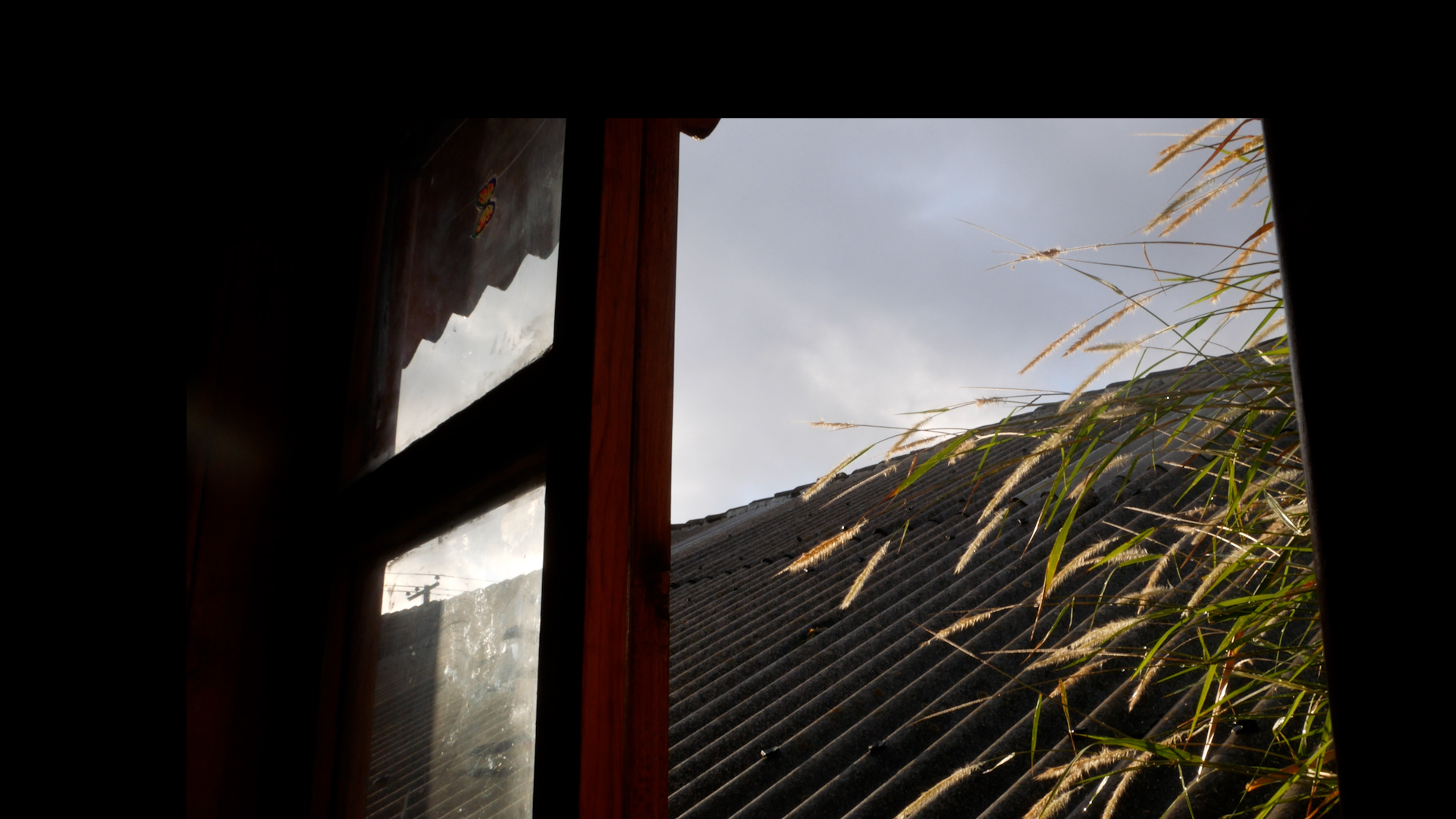It is 4:15pm on Thursday 25 January, 2024. I sit at my desk at my mother-in-law’s house in Comitán. Rain falls on a large tussock of grass behind me. I see it reflected in the screen of my laptop. It grows atop the wall that separates this house from the car-park next door. I listen to the rain through my headphones. My auditory perspective is displaced. The microphone sensing the rain’s acoustic energy is on the other side of the room, perched on the window that overlooks a banana tree whose leaves I watch swaying in the breeze. The broad green leaves yellow at the tips, splitting into fingers that move with the energy of the falling rain.
January is usually dry. The tropical rain comes as a blessing. A blessing expressing itself in synthesis through an analogue of barometric pressure, a voltage modulating a number of parameters in a pair of semi-modular synthesizers and an analogue sequencer.
The sounds of the synth and the signal from the microphone play through a small speaker. Ideally the feedback created by this setup would be just below the threshold of a constant tone, but enough to make louder sounds from the synth ring out. Today I may not have dialed it in quite so precisely. Regardless, the sounds of the rain and synthesizer resonate deeply with my being.
A description of the patch that you hear in this video
The tempo and pitch of the synthesizer sounds that we hear are being controlled by the changes in barometric pressure that are associated with the falling rain, temperature, and the time of day. The rain, coming in the afternoon as it does on this day, cools the air, causing pressure to rise.
The tempo of the sequence increases with the rising pressure. At around 01:20 minutes the rising pressure triggers a reset of the one of the voltages produced by the module and the tempo of the sequence abruptly slows. This happens again later in the recording.
The pitch of the oscillators is controlled by a voltage that that does not reset. Pitch also follows the rising pressure upwards but at a speed that is less-noticeable than the changes in tempo. A frequency modulation (FM) feedback loop runs between the two oscillators, and their tuning tracks slightly differently. This means that the changes in pitch also produce timbral changes.
Feedback
Audible pressure waves that travel through the air in a loop between microphone, amplifier and speaker produce one of the most common examples of feedback. This example depends on the propagation of acoustic energy through the air. When we control audio feedback it can produce information about the spatial relationships between the microphone, the speaker, and the surfaces in the room that reflect or absorb sound. Feedback can reveal the sonic characteristics of a space. From another perspective, acoustic feedback is a means for a space to know itself. The relationship between air, atmosphere, and feedback runs deep and operates at a planetary scale. It has a much longer history than the electronically mediated form of sonic feedback that I describe here.
Sensing temperature and the air
Air temperature operates in a feedback loop with our bodies to produce thermal homeostasis by triggering physiological and behavioural changes that help keep us warm or cool (such as sweating and shivering, moving into or out of the sun, removing or adding clothes). When atmospheric pressure gradients move the air our perception of temperature changes. The slightest breeze can modulate our experience of heat. Strong winds that often accompany a cool change can make the same temperature feel much colder.
Wind Chill is a term used to describe what the air temperature feels like to the human skin due to the combination of cold temperatures and winds blowing on exposed skin.
www.weather.gov
Our skin senses temperature and air pressure gradients in concert with one another. When I use air pressure to modulate the sounds of the synthesizer I am creating a sensory feedback loop that includes the skin sensing temperature and movements of the air, my auditory sense, and analogues of low frequency air pressure gradients embedded in the higher frequency pressure gradients of sound.
This is listening to the air through the air with my ears and my skin. This correlative listening through different sense modalities is embedded in the system of sonic and electronic feedback that produce the sounds that I hear.
Expression, atmosphere, mood
When I am setting up a patch I tweak parameters within the system in an attempt to better express my experience of air and atmosphere in that moment. I act in a way that is sensitive to the agency of the atmosphere and the synthesizer system. I stop when I feel the atmosphere expressing itself through the synthesizer.
The links between expression, atmosphere, mood, and affect run deep in art. The adjective atmospheric often blurs distinctions between metaphorical and more directly descriptive language. Many of William Turner’s paintings and watercolours are atmospheric in the sense that they are images of the atmosphere. They are also evocative of mood, expressive of sensation, and affecting, in a way that makes them more metaphorically atmospheric.
In this work the materials of watercolour allows Turner to express a blurring between land, ocean, and air in a way that might be seen to reflect the consciousness of all three elements in the mind of the lone figure of the gondolier, in the face of the gathering storm.

The atmosphere is an interface between land and bodies of water, from oceans, to rivers, lakes, puddles, and drops of dew. Watercolour can express certain dimensions of the relationship between water, land and atmosphere. The synthesizer has its own expressive possibilities when working with analogues of air. Part of my work here is in exploring these possibilities.
When the air recognises itself
Every living cell has some form of feedback that allows it to modulate its metabolic processes in relation what it senses of its surroundings. Feedback, it can be argued, is the basis of individuation and the self/other distinction.
When I feel the air moving across my skin and sense its temperature I am aware of the skin as a boundary between my cells and the environment. The feedback that my skin provides is part of my conscious experience of a particular form of the self/other distinction. I recognise my skin’s sensing of temperature and the movements of air as my own in a way that is related to my recognition of my own face in the mirror.
When we listen to the air through the air we create a feedback loop that allows the air to recognise itself. I say this based on nothing more than my experience. I know only a fraction of what this statement might mean. This is one of the more speculative aspects of my work, so take this notion with as many grains of salt as you like. Regardless, it is important for me to state clearly that in listening to air pressure changes through the synthesizer I have experienced moments of the air as an entity that recognises itself.
Biological Modulation, feedback
‘Biological Modulation of the Earth’s Atmosphere’ by Lynn Margulis and James Lovelock (1973) is one of a series of papers in which the authors describe the Gaia hypothesis. In this paper Margulis and Lovelock tell us that they
believe that Gaia is a complex entity involving the earth’s atmosphere, biosphere, oceans and soil. The totality constitutes a feedback or cybernetic system which seeks an optimal physical and chemical environment for the biota.
Later they write
…the earth’s atmosphere-biosphere contains many cybernetic control systems responsible for maintenance of levels of temperature, acidity and composition tolerable to the earth’s biota.
The planet uses biological feedback to modulate temperature, a form of thermal homeostasis that is analogous to the bodily processes I described earlier. Life does this, in part, by balancing the levels of carbon, oxygen, nitrogen, and water in the atmosphere. Atmosphere and biosphere are so interconnected that it makes sense for us to think about them together as one thing (the ‘atmosphere-biosphere’).
Margulis and Lovelock state that Gaia seeks ‘an optimal physical and chemical environment for the biota’. Elsewhere Margulis and Dorian Sagan describe how oxygen levels in the atmosphere are the product of a planetary consensus originally created by microbial cells. A consensus that gives aerobic organisms access to the oxygen we need to power our metabolisms, while balancing these energetic requirements with the greater risk of wild-fires if atmospheric oxygen levels were to rise.
This balance of the atmosphere-biosphere produces a metabolic commons. The atmosphere-biosphere creates the terminal electron receptor for all oxygen respiring organisms. It cycles carbon, water, and nitrogen, (elements that are fundamental to all metabolic processes) through cellular bodies of all sizes and degrees of complexity. Atmosphere and biosphere are as inseparable as our organs are from the rest of our bodies. The biosphere maintains the atmosphere and vice versa.
According to Margulis and Sagan, what we now know as bacteria and archaea, the inventors of all forms of metabolism that produce the atmosphere-biosphere as a coherent entity, established a consensus on the composition of our atmosphere around 1.5 billion years ago.
The weight of that consensus, the weight of air above me, pushes biologically produced oxygen into my blood, fueling my metabolism. My body is made of carbon and nitrogen plucked from the air by plants and bacteria. Plants turn air into matter, my cells turn their matter into my body.
The air’s substance passes through me. I am part of its metabolism. I am both one with it, and a distinct entity.
When I listen to changes in barometric pressure through my synthesizer I experience pressure waves created, in significant part, by the earth spinning on its axis. When I think about earth and air in motion I loosen the grip of the illusion of stillness that comes from being on the ground. I see the earth from the tactile perspective of the atmosphere. I swim in the organically produced ocean that is the air that also made my body. In the most special moments, I become the air.
Duende
the duende seizes not only the performer but also the audience, creating conditions where art can be understood spontaneously with little, if any, conscious effort…
https://en.wikipedia.org/wiki/Duende_(art)
Duende, in this connection, is an entity that comes from the air. In the example of Flamenco, duende recognises themselves in the way that the musicians and dancers give structure to the air. Duende lives in the air. Listening to air presure changes through a synthesizer can lead to encounters with duende.
Questions
Can the feedback mechanisms of the atmosphere-biosphere that produce the entity we call Gaia also give her the ability to recognise herself? If we listen to the air can we hear moments of that recognition? Are there other kinds of entities that might hear and recognise themselves in air pressure gradients made audible by a synthesizer system? Can humans become such entities?
